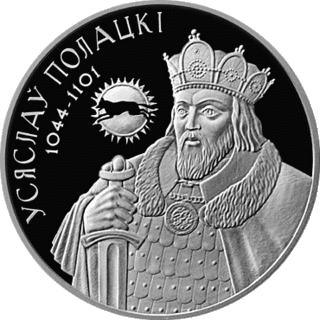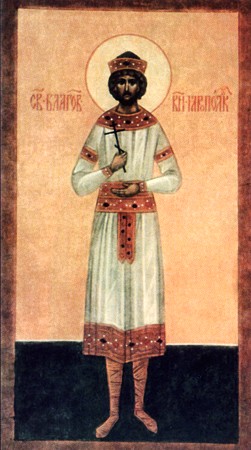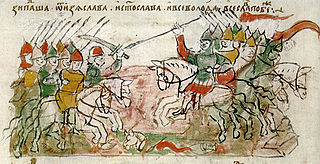
Vladimir I Sviatoslavich or Volodymyr I Sviatoslavych, nicknamed the Great, was Prince of Novgorod from 970 and Grand Prince of Kiev from 978 until his death in 1015. The Eastern Orthodox Church canonised him as Saint Vladimir.

Yaroslav I Vladimirovich, better known as Yaroslav the Wise, was Grand Prince of Kiev from 1019 until his death in 1054. He was also earlier Prince of Novgorod from 1010 to 1034 and Prince of Rostov from 987 to 1010, uniting the principalities for a time. Yaroslav's baptismal name was George after Saint George.

Yaropolk I Sviatoslavich was a young and rather enigmatic ruler of Kiev between 972 and 980. He was the oldest son of Svyatoslav. His royal title is traditionally translated as "Prince".

Rogneda Rogvolodovna, also known as Gorislava or Ragnhild (Ragnheiðr), was a princess of Polotsk and one of the wives of Vladimir the Great. She was the daughter of Rogvolod (Ragnvald), who came from Scandinavia and established himself at Polotsk in the mid-10th century.
Sviatoslav II Iaroslavich or Sviatoslav II Yaroslavich was Grand Prince of Kiev between 1073 and 1076. He was born as a younger son of Grand Prince Yaroslav the Wise, and became the progenitor of the Sviatoslavichi (Svyatoslavychi). His baptismal name was Nicholas.

Vseslav of Polotsk or Vseslav Bryachislavich, also known as Vseslav the Sorcerer or Vseslav the Seer, was the most famous ruler of Polotsk and was briefly Grand Prince of Kiev in 1068–1069. Together with Rostislav Vladimirovich and voivode Vyshata, they created a coalition against the Yaroslaviches' triumvirate. Polotsk's Cathedral of Holy Wisdom is one of the most enduring monuments on the lands of modern Belarus and dates to his 57-year reign.
Oleg Svyatoslavich was a Sviatoslavichi prince whose equivocal adventures ignited political unrest in Kievan Rus' at the turn of the 11th and 12th centuries. He reigned as Prince of Chernigov from 1097 to 1115, and was the progenitor of the Olgovichi family.
The family life and children of Vladimir I, popularly known as Vladimir the Great (c.958–1015), grand prince of Kievan Rus', is subject to scholarly studies. The primary sources about his life, such as the Primary Chronicle and the Chronicon Thietmari of Thietmar of Merseburg, are legendary, and require critical scrutiny to separate fact from fiction.

The Principality of Polotsk, also known as the Duchy of Polotsk or Polotskian Rus', was a medieval principality of the Early East Slavs. The origin and date of state establishment is uncertain. Chronicles of Kievan Rus' mention Polotsk being conquered by Vladimir the Great, and thereafter it became associated with Kievan Rus' and its ruling Rurik dynasty.

Boris Stones, also called Dvina Stones, are seven medieval artifacts erected along the bank of the Western Dvina between Polotsk and Drissa, Belarus. They probably predate Christianity in the area, but were inscribed in the 12th century with text and an image of Christ. The largest of the stones is 17 metres in circumference.
The Prince of Polotsk ruled the Principality of Polotsk within the realm of Kievan Rus' or within the Grand Duchy of Lithuania from the mid-9th century to 1307.

Yaropolk Iziaslavich or Yaropolk Iziaslavych was a Kniaz (prince) during the eleventh-century in the Kievan Rus' kingdom and was the King of Rus (1076–1087). The son of Grand Prince Iziaslav I of Kiev (Kyiv) by a Polish princess named Gertruda, he is visible in papal sources by the early 1070s but largely absent in contemporary Rus sources until his father's death in 1078. During his father's exile in the 1070s, Yaropolk can be found acting on his father's behalf in an attempt to gain the favor of the German emperors and the papal court of Pope Gregory VII. His father returned to Kiev in 1077 and Yaropolk followed.

The Battle on the Nemiga River was a battle of the Kievan Rus' feudal period that occurred on March 3, 1067 on the Niamiha River. The description of the battle is the first reference to Minsk in the chronicles of Belarusian history.

The Rurik dynasty, also known as the Rurikid or Riurikid dynasty, as well as simply Rurikids or Riurikids, was a noble lineage allegedly founded by the Varangian prince Rurik, who, according to tradition, established himself at Novgorod in the year 862. The Rurikids were the ruling dynasty of Kievan Rus' and its principalities followings its disintegration.
The Principality of Drutsk was a small appanage principality of the Polotsk principality and was centred in Drutsk. It was located on a three way stick between Vitebsk, Minsk and Mogilev regions in modern Belarus.

The Principality of Turov, later called the Principality of Turov and Pinsk, also known as Turovian Rus', was a medieval principality of Kievan Rus' from the 10th century on the territory of modern-day Belarus and northern Ukraine. The princes of Turov often served as grand princes early in 10th and 11th centuries. Its capital was Turov, and other important cities included Pinsk, Mazyr, Slutsk, Lutsk, Brest, and Volodymyr.

Gleb Vseslavich was the prince of Minsk between 1101 and 1119. During his reign Minsk was at war with Kiev and Polatsk. He started the Minsk branch of Prince of Polotsk as son of Vseslav the Seer.
The Principality of Minsk was an appanage principality of the Principality of Polotsk and centered on the city of Minsk. It existed from its founding in 1101 until it was nominally annexed by the Grand Duchy of Lithuania in 1242, and then fell under de facto annexation in 1326.
The Principality of Vitebsk was a Ruthenian principality centered on the city of Vitebsk in modern Belarus, that existed from its founding in 1101 until it was nominally inherited into the Grand Duchy of Lithuania in 1320. Vitebsk would later fall under the complete authority of Lithuania in 1508.
Volodar Glebovich of Minsk was a prince of Minsk belonging to the so-called Polotsk dynasty after the city and the principality Polotsk from where it originated. He was the son of Gleb Vseslavich of Minsk and Anastasia, a daughter of Yaropolk Izyaslavich. Volodar died after 1167, possibly 1176.












